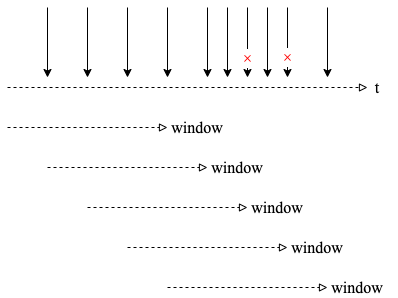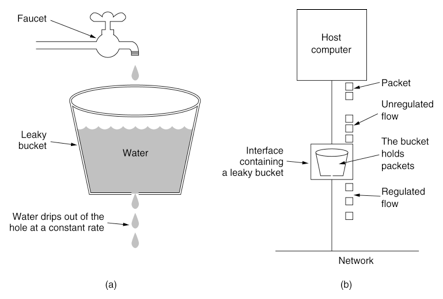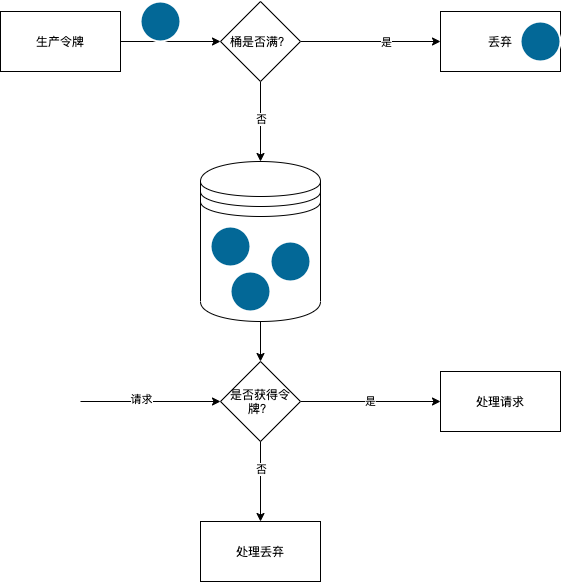限流算法
限流,是一种自我保护的机制,服务端通过一些限流手段控制并发访问请求,目的是为了防止系统因突发流量导致服务不可用或者崩溃。
常用的限流方法:
- 计数器限流
- 滑动窗口限流
- 漏桶限流
- 令牌桶限流
计数器限流
在一段时间间隔内,对请求进行计数,与阈值进行比较判断是否需要限流 时间结束后重置计数器 因此计数器限流也叫固定时间限流

如图所示,假设每秒钟限流5次,那么接下来的第6次、第7次...会被拒绝,但下一秒钟又可以继续访问,直到达到限流5次后,又被拒绝。
单机版
type CounterLimiter struct {
mux sync.Mutex
ctime time.Time
cycle time.Duration
counter int
limit int
}
func NewCounterLimiter(limit int, cycle time.Duration) *CounterLimiter {
return &CounterLimiter{
mux: sync.Mutex{},
ctime: time.Now(),
cycle: cycle,
counter: 0,
limit: limit,
}
}
func (c *CounterLimiter) Reset() {
c.ctime = time.Now()
c.counter = 0
}
func (c *CounterLimiter) Allow() bool {
c.mux.Lock()
defer c.mux.Unlock()
now := time.Now()
if now.Sub(c.ctime) >= c.cycle {
c.Reset()
return true
}
if c.counter >= c.limit {
return false
}
c.counter++
return true
}测试
func TestCounterLimiter_Allow(t *testing.T) {
c := NewCounterLimiter(5, time.Second)
var wg sync.WaitGroup
wg.Add(10)
for i := 0; i < 10; i++ {
go func() {
defer wg.Done()
if allow := c.Allow(); allow {
t.Log("allow")
time.Sleep(time.Millisecond * 200) //模拟处理耗时
} else {
t.Log("unallow")
}
}()
time.Sleep(time.Millisecond * 100)
}
wg.Wait()
}测试结果,由于我们限制了每秒种只能处理5个请求,前5个运行通过,后5个由于限流,不允许通过
=== RUN TestCounterLimiter_Allow
counter_test.go:17: allow
counter_test.go:17: allow
counter_test.go:17: allow
counter_test.go:17: allow
counter_test.go:17: allow
counter_test.go:20: unallow
counter_test.go:20: unallow
counter_test.go:20: unallow
counter_test.go:20: unallow
counter_test.go:20: unallow但是计数器限流存在一个问题,如下图所示:

假设限制每秒钟限流5个请求 虽然在00:00:30-00:00:31之前有5个请求,但没有超过5个,00:00:31-00:00:32之间有5个请求,但也没有超过5个。 但是在00:00:31秒附近确有10次请求。 我们模拟这种场景测试如下:
func TestCounterLimiter_Allow2(t *testing.T) {
c := NewCounterLimiter(5, time.Second)
var wg sync.WaitGroup
wg.Add(10)
worker := func() {
defer wg.Done()
if allow := c.Allow(); allow {
t.Log("allow")
time.Sleep(time.Millisecond * 200) //模拟处理耗时
} else {
t.Log("unallow")
}
}
time.Sleep(time.Millisecond * 900)
for i := 0; i < 5; i++ {
go worker()
}
time.Sleep(time.Millisecond * 100)
for i:=0;i<5;i++{
go worker()
}
time.Sleep(time.Millisecond*900)
wg.Wait()
}测试结果:
=== RUN TestCounterLimiter_Allow2
counter_test.go:35: allow
counter_test.go:35: allow
counter_test.go:35: allow
counter_test.go:35: allow
counter_test.go:35: allow
counter_test.go:35: allow
counter_test.go:35: allow
counter_test.go:35: allow
counter_test.go:35: allow
counter_test.go:35: allow很显然计数器限流存在临界值问题,限流不够均衡。假设极端情况下,在临界值附近有2倍的流量,很显然我们的系统会处理不过来。
分布式
分布式是当前的主流模式,在分布式环境下我们可以使用redis+lua脚本实现计数器限流
-- KEYS[1] target key
-- KEYS[2] max count key from redis config
-- ARGV[n = 3] max count, duration(milliseconds), current timestamp
-- HASH: KEYS[1]
-- field:count
-- field:limit
-- field:duration
-- field:reset
local res = {}
local limit = redis.call('hmget', KEYS[1], 'count', 'limit', 'duration', 'reset')
if limit[1] then
res[1] = tonumber(limit[1]) - 1
res[2] = tonumber(limit[2])
res[3] = tonumber(limit[3]) or ARGV[3]
res[4] = tonumber(limit[4])
if res[1] >= -1 then
redis.call('hincrby', KEYS[1], 'count', -1)
else
res[1] = -1
end
else
local total = tonumber(redis.call('get', KEYS[2]) or ARGV[2])
res[1] = total - 1
res[2] = total
res[3] = tonumber(ARGV[3])
res[4] = tonumber(ARGV[1]) + res[3]
redis.call('hmset', KEYS[1], 'count', res[1], 'limit', res[2], 'duration', res[3], 'reset', res[4])
redis.call('pexpire', KEYS[1], res[3])
end
return res测试
package main
import (
"fmt"
"html"
"log"
"net/http"
"strconv"
"time"
"github.com/garyburd/redigo/redis"
)
var conn redis.Conn
const lua string = `
-- KEYS[1] target key
-- KEYS[2] max count key from redis config
-- ARGV[n = 3] max count, duration(milliseconds), current timestamp
-- HASH: KEYS[1]
-- field:count
-- field:limit
-- field:duration
-- field:reset
local res = {}
local limit = redis.call('hmget', KEYS[1], 'count', 'limit', 'duration', 'reset')
if limit[1] then
res[1] = tonumber(limit[1]) - 1
res[2] = tonumber(limit[2])
res[3] = tonumber(limit[3]) or ARGV[3]
res[4] = tonumber(limit[4])
if res[1] >= -1 then
redis.call('hincrby', KEYS[1], 'count', -1)
else
res[1] = -1
end
else
local total = tonumber(redis.call('get', KEYS[2]) or ARGV[2])
res[1] = total - 1
res[2] = total
res[3] = tonumber(ARGV[3])
res[4] = tonumber(ARGV[1]) + res[3]
redis.call('hmset', KEYS[1], 'count', res[1], 'limit', res[2], 'duration', res[3], 'reset', res[4])
redis.call('pexpire', KEYS[1], res[3])
end
return res
`
func init() {
var err error
conn, err = redis.Dial("tcp", "localhost:6379")
if err != nil {
panic(err)
}
}
func main() {
defer conn.Close()
total := "5"
s := redis.NewScript(2, lua)
http.HandleFunc("/", func(w http.ResponseWriter, r *http.Request) {
if r.URL.Path == "/" {
now := strconv.FormatInt(time.Now().UnixNano()/1e6, 10)
duration := strconv.FormatInt(10*time.Second.Milliseconds(), 10)
log.Println(total, now, duration)
v, err := redis.Ints(s.Do(conn, "user-1001", "total-user", now, total, duration))
if err != nil {
http.Error(w, err.Error(), 500)
return
}
if v[0] >= 0 {
w.WriteHeader(200)
fmt.Fprintf(w, "Path: %q\n", html.EscapeString(r.URL.Path))
fmt.Fprintf(w, "Remaining: %d\n", v[0])
fmt.Fprintf(w, "Total: %d\n", v[1])
fmt.Fprintf(w, "Duration: %v\n", v[2])
fmt.Fprintf(w, "Reset: %v\n", v[3])
} else {
w.WriteHeader(429)
fmt.Fprintf(w, "Rate limit exceeded, retry seconds.\n")
}
}
})
log.Fatal(http.ListenAndServe(":8080", nil))
}滑动窗口限流
滑动窗口(Sliding Window)限流在每次检查时,查看最近窗口(例如10秒钟)的请求次数,如果超过最大次数(例如5次)就拒绝,反之则允许 由于时间窗口是滑动的即没有像计数器限流固定的临界点,解决了计数器的临界问题

分布式
local res = {}
local key = KEYS[1]
local score = tonumber(ARGV[1])
local limit = tonumber(redis.call('get', KEYS[2]) or ARGV[2])
local duration = tonumber(ARGV[3])
local max = tonumber(score - duration*1000000)
redis.call("zremrangebyscore", key, 0, max)
local count = redis.call("zcard", key)
if count >= limit then
res[1] = -1
else
res[1] = limit - count - 1
redis.call("zadd", key, score, score)
redis.call("pexpire", key, duration)
end
res[2] = limit
res[3] = duration
res[4] = duration*100000 + score
return res测试
package main
import (
"fmt"
"html"
"log"
"net/http"
"strconv"
"time"
"github.com/garyburd/redigo/redis"
)
const limitWindow =`
local res = {}
local key = KEYS[1]
local score = tonumber(ARGV[1])
local limit = tonumber(redis.call('get', KEYS[2]) or ARGV[2])
local duration = tonumber(ARGV[3])
local max = tonumber(score - duration*1000000)
redis.call("zremrangebyscore", key, 0, max)
local count = redis.call("zcard", key)
if count >= limit then
res[1] = -1
else
res[1] = limit - count - 1
redis.call("zadd", key, score, score)
redis.call("pexpire", key, duration)
end
res[2] = limit
res[3] = duration
res[4] = duration*100000 + score
return res
`
var connWindow redis.Conn
func init() {
var err error
connWindow, err = redis.Dial("tcp", "localhost:6379")
if err != nil {
panic(err)
}
}
func main() {
defer connWindow.Close()
total := "5"
s := redis.NewScript(2, limitWindow)
http.HandleFunc("/", func(w http.ResponseWriter, r *http.Request) {
if r.URL.Path == "/" {
now := strconv.FormatInt(time.Now().UnixNano()/1e6, 10)
duration := strconv.FormatInt(10*time.Second.Milliseconds(), 10)
log.Println(total, now, duration)
v, err := redis.Ints(s.Do(connWindow, "user-1001", "total-user", now, total, duration))
if err != nil {
http.Error(w, err.Error(), 500)
return
}
if v[0] >= 0 {
w.WriteHeader(200)
fmt.Fprintf(w, "Path: %q\n", html.EscapeString(r.URL.Path))
fmt.Fprintf(w, "Remaining: %d\n", v[0])
fmt.Fprintf(w, "Total: %d\n", v[1])
fmt.Fprintf(w, "Duration: %v\n", v[2])
fmt.Fprintf(w, "Reset: %v\n", v[3])
} else {
w.WriteHeader(429)
fmt.Fprintf(w, "Rate limit exceeded, retry seconds.\n")
}
}
})
log.Fatal(http.ListenAndServe(":8080", nil))
}漏桶限流
漏桶算法(Leaky Bucket)主要目的是控制数据注入到网络的速率,平滑网络上的突发流量。 漏桶可以看作是一个带有常量服务时间的单服务器队列,如果漏桶(包缓存)溢出,那么数据包会被丢弃。 如图所示,把请求比作是谁,水来了都先放进桶里,并以限定的速度出水,当水来的过猛而出水不够快时就会导致水直接溢出。

单机版
uber团队开源的漏桶,使用比较简单。
package main
import (
"fmt"
"time"
"go.uber.org/ratelimit"
)
func main() {
rl := ratelimit.New(100) // per second
prev := time.Now()
for i := 0; i < 10; i++ {
now := rl.Take()
fmt.Println(i, now.Sub(prev))
prev = now
}
}令牌桶限流
令牌桶算法包含三个过程:
- 生产令牌:以固定的速率向令牌桶中增加令牌,如果桶中令牌个数达到上限,则丢弃多余令牌;
- 消费令牌:每来一次请求,就会消耗桶中的令牌,可以对耗时高的请求增加每次消费的令牌个数;
- 判断是否通过:请求到来,根据消费的令牌个数是否小于等于桶中令牌个数,如果满足则允许通过,否则不允许通过;

分布式
-- KEYS[1] target key
-- ARGV[n = 3] current timestamp, max count, interval
-- HASH: KEYS[1]
-- field: count
-- field: limit
-- field: interval
-- field: timestamp
local res = {}
local curr_timestamp = tonumber(ARGV[1])
local limit = redis.call('hmget', KEYS[1], 'count', 'limit', 'interval', 'timestamp')
if limit[1] then
local count = tonumber(limit[1])
local total = tonumber(limit[2])
local interval = tonumber(limit[3])
local last_timestamp = tonumber(limit[4])
--计算上一次放令牌到现在的时间间隔中,一共应该放入多少令牌
local increase_token = math.max(0, math.floor((curr_timestamp - last_timestamp) / interval))
local token = math.min(total, count + increase_token)
res[1] = token
--取令牌
if token >0 then
res[1] = token - 1
end
--更新当前桶中的令牌数量
redis.call('hset', KEYS[1], 'count', res[1])
res[2] = total
res[3] = interval
res[4] = last_timestamp
if increase_token >0 then
--如果这次有放入令牌,则更新时间
res[4] = curr_timestamp
redis.call('hset', KEYS[1], 'timestamp', res[4])
end
else
local total = tonumber(ARGV[2])
res[1] = total - 1
res[2] = total
res[3] = tonumber(ARGV[3])
res[4] = curr_timestamp
redis.call('hmset',KEYS[1],'count',res[1],'limit',res[2],'interval',res[3],'timestamp',res[4])
end
return res